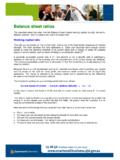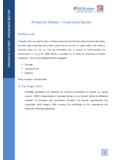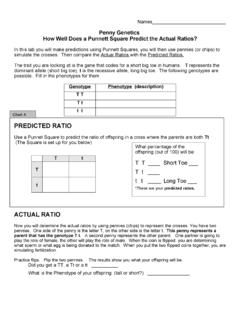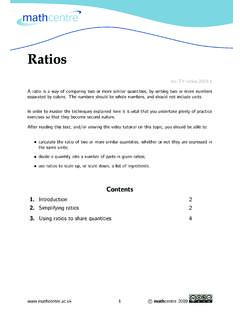Transcription of 16 Financial Ratios for Analyzing a Company’s …
1 18 AAII JournalIn the previous install-ments of AAII s Financial Statement Analysis series, I discussed the three most commonly used Financial statements the income state-ment, balance sheet and cash fl ow this installment of the series, I take an in-depth look at the most commonly used fi nancial Ratios . The online ver-sion of this article includes a downloadable spreadsheet that automatically calculates these Ratios using fi nancial statement inputs that you provide. The online version also gives detailed explanations on creating the Ratios for Stock Investor Pro AnalysisOver the years, investors and analysts have developed numerous analytical tools, concepts and techniques to com-pare the relative strengths and weaknesses of companies. These tools, concepts and techniques form the basis of fundamental analysis is a tool that was developed to perform quantitative analysis on numbers found on fi nancial state-ments.
2 Ratios help link the three fi nancial statements together and offer fi gures that are comparable between companies and across industries and sectors. Ratio analysis is one of the most widely used fundamental analysis , fi nancial Ratios vary across different industries and sectors and comparisons be-tween completely different types of companies are often not valid. In addition, it is important to analyze trends in company Ratios instead of solely emphasizing a single period s fi is a ratio? It s a mathematical expression relating one number to another, often providing a relative comparison. Financial Ratios are no different they form a basis of comparison between fi gures found on fi nancial statements. As with all types of fundamental analysis, it is often most useful to compare the fi nancial Ratios of a fi rm to those of other Ratios fall into several categories.
3 For the pur-pose of this analysis, the commonly used Ratios are grouped into four categories: activity, liquidity, solvency and profi t-ability. Also, for the sake of consistency, the data in the fi nancial statements created for the prior installments of the Financial Statement Analysis series will be used to illustrate the Ratios . Table 1 shows the formulas with examples for each of the Ratios RatiosActivity Ratios are used to measure how effi ciently a company utilizes its assets. The Ratios provide investors with an idea of the overall operational performance of a fi you can see from Table 1, the activity Ratios are turnover Ratios that relate an income statement line item 16 financial ratios for analyzing a Company s Strengths and WeaknessesBy Z. Joe LanArticle Highlights Ratios provide a common means for comparing the fi nancial strength and performance of two or more companies.
4 Ratios can reveal a company s fi nancial strength or weakness as well as reveal trends about business conditions and profi tability. Formulas for 16 commonly used Ratios are 2012 Financial Statement AnalysisFinancial Statement Analysis Example data comes from the income statement, balance sheet and cash fl ow statement found in the Financial Statement Analysis columns in the March, May and July 2012 issues of the AAII Journal, which are linked to this table amounts are in millions of RatiosInventory turnover = cost of goods sold average inventory = $500 $190 = turnover = net revenue average receivables = $1,000 $ = turnover = purchases* average payables = $520 $90 = turnover = net revenues average total assets = $1,000 $1,391 = RatiosCurrent ratio = current assets current liabilities = $685 $750 = ratio = (cash + short-term marketable securities + accounts receivable)
5 Current liabilities = $340 $750 = ratio = (cash + short-term marketable securities) current liabilities = $200 $750 = RatiosDebt-to-assets ratio = total liabilities total assets = $1,067 $1,485 = , or 72%Debt-to-capital ratio = total debt* (total debt* + total shareholder s equity) = $517 $935 = , or 55%Debt-to-equity ratio = total debt* total shareholder s equity = $517 $418 = , or 124%Interest coverage ratio = earnings before interest and taxes* interest payments = $230 $100 = tability RatiosGross profi t margin = gross income net revenue = $500 $1,000 = , or 50%Operating profi t margin = operating income net revenue = $180 $1,000 = , or 18%Net profi t margin = net income net revenue = $ $1,000 = , or on assets (ROA) = net income total assets = $ $1,485 = , or on equity (ROE) = net income total stockholder s equity = $ $418 = , 20%*calculated terms: purchases = cost of goods sold + ending inventory beginning inventory = $500 + $200 $180 = $520 total debt = notes payable + current portion of long-term debt + long-term debt = $100 + $150 + $267 = $517 earnings before interest and taxes = net income + income taxes + interest expense = $ + $ + $100 = $230 Table 1.
6 Financial Ratio Formulas & Examplesto a balance sheet line item. As explained in my previous articles, the in-come statement measures performance over a speci-fi ed period, whereas the balance sheet presents data as of one point in time. To make the items comparable for use in activity Ratios , an average fi gure is calculated for the balance sheet data using the beginning and ending reported numbers for the period (quarter or year).The activity Ratios measure the rate at which the company is turning over its assets or liabilities. In other words, they pres-ent how many times per year inventory is replen-ished or receivables are turnoverInventory turnover is calculated by dividing cost of goods sold by av-erage inventory. A higher turnover than the industry average means that inven-tory is sold at a faster rate, signaling inventory management effectiveness.
7 Additionally, a high inven-tory turnover rate means less company resources are tied up in inventory. However, there are usu-ally two sides to the story of any ratio. An unusually high inventory turnover rate can be a sign that a company s inventory is too lean, and the fi rm may be unable to keep up with any increased demand. Furthermore, inventory turnover is very industry-specific. In an industry where inventory gets stale quickly, you should seek out companies with high 20 AAII Journalinventory our example in Table 1, the in-ventory turnover ratio of means that inventory was turned over or replenished times during a period of one year. (This equates to inventory being turned over once every 140 days, or 365 days ) The inventory fi gure used, $190 million, is calculated using a beginning inventory of $180 million on December 31, 2010, and an ending inventory of $200 million on December 31, 2011.
8 The $190 million represents the average inventory held during 2011, the time period when $500 million was generated in cost of goods forward, a decrease in inven-tory or an increase in cost of goods sold will increase the ratio, signaling improved inventory effi ciency (sell-ing the same amount of goods while holding less inventory or selling more goods while holding the same amount of inventory). Receivables turnoverThe receivables turnover ratio is calculated by dividing net revenue by average receivables. This ratio is a measure of how quickly and effi ciently a company collects on its outstanding bills. The receivables turnover indicates how many times per period the company collects and turns into cash its custom-ers accounts Table 1, the receivables turnover is , signaling that, on average, re-ceivables were fully collected times during the period or once every 47 days (365 ).
9 Once again, a high turnover com-pared to that of peers means that cash is collected more quickly for use in the company, but be sure to analyze the turnover ratio in relation to the fi rm s competitors. A very high receivables turnover ratio can also mean that a company s credit policy is too stringent, causing the fi rm to miss out on sales opportunities. Alternatively, a low or declining turnover can signal that cus-tomers are struggling to pay their bills. Payables turnoverPayables turnover measures how quickly a company pays off the money owed to suppliers. The ratio is calculated by dividing purchases (on credit) by average payables turnover of suggests that, on average, the fi rm used and paid off the credit extended times during the period or once every 63 days (365 days ).
10 The payables turnover increases as more purchases are made or as a company decreases its accounts high number compared to the industry average indicates that the fi rm is paying off creditors quickly, and vice versa. An unusually high ratio may sug-gest that a fi rm is not utilizing the credit extended to them, or it could be the result of the company taking advantage of early payment discounts. A low pay-ables turnover ratio could indicate that a company is having trouble paying off its bills or that it is taking advantage of lenient supplier credit sure to analyze trends in the payables turnover ratio, as a change in a single period can be caused by timing issues such as the fi rm acquiring ad-ditional inventory for a large purchase or to gear up for a high sales season. Also understand that industry norms can vary turnoverAsset turnover measures how ef-fi ciently a company uses its total assets to generate revenues.






